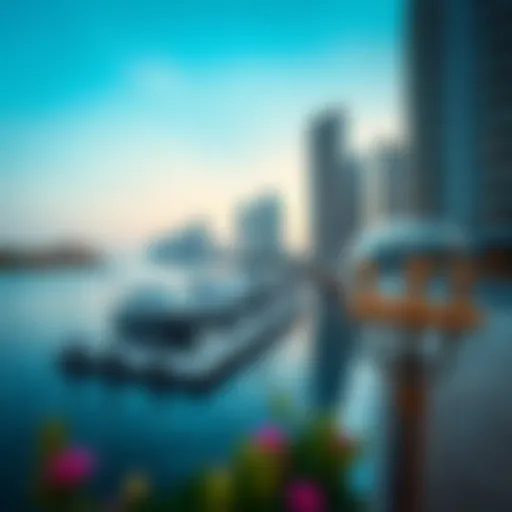The Deira Clocktower: A Symbol of Dubai's Heritage
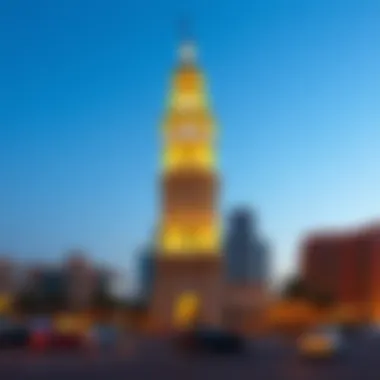

Intro
Nestled in the vibrant hub of Deira, the Deira Clocktower stands as a testament to Dubai's remarkable journey from a quiet trading port to a bustling metropolis. This iconic structure not only serves as a timekeeper for the daily rhythm of the city but also symbolizes the rapid transformation that has defined Dubai over the decades.
With its elegant design and strategic location, the clocktower plays a pivotal role in the urban tapestry of Dubai. It acts as a central meeting point, guiding both locals and tourists through the bustling streets that surround it. Understanding its significance requires stepping back in time to explore its architectural features, the neighborhood's evolution, and the cultural narratives that it encapsulates.
This article will take a closer look at the Deira Clocktower's impact on the area, how it has shaped the identity of the neighborhood, and its lasting relevance in today's Dubai.
By diving deeper into its historical context and contemporary role, we will uncover how this landmark helps to illustrate the rich story of Dubai's growth and the complex interplay between tradition and modernity. As we journey through its past and explore its significance in the current landscape, readers will come to appreciate not just a clock, but a symbol of resilience and progress.
Prologue to the Deira Clocktower
The Deira Clocktower stands as a monument not merely to time, but also to the very essence of Dubai's identity and progress. This landmark, which has graced the skyline of Deira for decades, encapsulates the city’s transformation from a humble trading hub to a dynamic global metropolis. The importance of this clocktower transcends its function of keeping time; it serves as a beacon that signifies the rich historical narrative of the region while also reflecting its contemporary aspirations.
When discussing the Deira Clocktower, one must consider its central role in shaping the urban landscape of Dubai. It is more than just an architectural structure; it is a vital landmark that connects various elements of the city, echoing the added vibrancy that Dubai has gained over the years. As an investor, real estate agent, or homeowner, understanding the significance of such landmarks enhances your knowledge about the city’s real estate market and cultural heritage, which are deeply intertwined.
Moreover, the clocktower acts as a focal point around which public life thrives. Locals and tourists alike are drawn to it, contributing to its status as a meeting place and a symbol of community and connection. This intersection of people from different backgrounds showcases Dubai’s spirit of cosmopolitanism, making it an integral part of the urban fabric.
Key Elements of Preface to the Deira Clocktower
- Symbolic Significance: The clocktower represents the historical evolution of Dubai, serving as a reminder of the city’s roots.
- Architectural Importance: Analyzing the design and construction provides insights into the aesthetic and functionality choices made during its erection.
- Impact on Urban Life: Examining the clocktower’s role in public spaces reveals how it fosters community interaction and tourism.
- Historical Context: Understanding its origins puts into perspective how it has adapted and remained relevant through the years.
In essence, the Deira Clocktower is a cornerstone that showcases the juxtaposition of Dubai’s historic past with its ambitious future. By delving into its story, we can better appreciate the intricate narratives that shape the city we see today.
"The Deira Clocktower is not just a clock; it is a clock of transformation, a witness to the change that has etched itself into the very soul of Dubai."
For those keen on exploring the deeper layers of Dubai’s urban tapestry, understanding the significance of the Deira Clocktower is essential.
Historical Context
Understanding the historical context of the Deira Clocktower is essential for grasping its role in the urban landscape of Dubai. This landmark is much more than a mere timekeeper; it stands as a testament to the city's evolution from a humble trading post to a modern metropolis. Its significance transcends time, embodying the cultural threads that have shaped Dubai over the decades.
Origins of the Deira Clocktower
The origins of the Deira Clocktower date back to 1965 when it was erected to welcome travelers arriving at the bustling Dubai International Airport. The structure was commissioned to serve as a comfortable point of reference for both locals and visitors navigating the rapidly growing city. Its elegant façade, complemented by vibrant landscaping, created an inviting aura, marking it as a focal landmark.
The clocktower was designed by the architect Abdullah Al Mulla, and its modernist style reflects the ambition and aspirations of Dubai during that era. As Dubai started to shed its earlier identities tied to fishing and pearling, the clocktower emerged as a symbol of progress—a clock that didn’t just tell time but also narrated the story of a city's desires and dreams.
The Clocktower's Role in Dubai's Development
The clocktower has played a pivotal role in the orientation and development of Dubai. Initially, it functioned as a key navigational landmark for those venturing into the burgeoning urban sprawl.
As the city expanded, the surroundings witnessed a flurry of infrastructural developments. The clocktower found itself at the heart of vital roadways, linking various neighborhoods and commerce hubs.
Some key points about its influence:
- It facilitated easier navigation through Deira, helping to bridge the gap between different communities.
- The area around the clock tower saw a surge in business, with shops and markets flourishing nearby, which resulted in more job opportunities.
- It became a popular meeting point for residents and visitors alike, fostering a sense of community.
Through these dynamics, the Deira Clocktower became enmeshed in Dubai's overall development, symbolizing not just time but the rapid changes experienced throughout the city.
Cultural Significance Over the Decades
Over the years, the clocktower has firmly established itself as a cultural icon. Its presence can be felt during significant local events and celebrations, such as the Dubai Shopping Festival and UAE National Day, where it often serves as the backdrop for festivities.
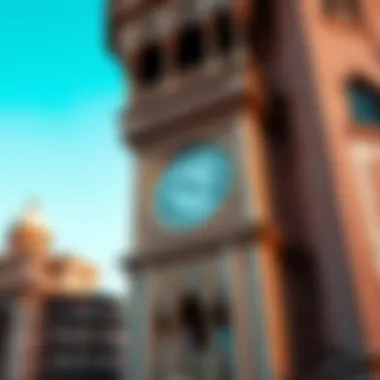

However, the cultural significance of the clocktower reaches beyond just events. Here’s why it matters:
- Symbol of Unity: The clocktower stands as a unifying figure amid Dubai's diverse populace. It bridges cultural gaps and represents a collective heritage.
- Inspiration for Local Art: Countless local artists have drawn inspiration from the clocktower, incorporating its image into their works, reflecting the city’s evolving narrative.
- A Snapshot of Change: Each new tick of the clock is a reminder of Dubai’s transformation, serving as a historical marker that captures both the aspirations and the realities of life in this dynamic city.
"The Deira Clocktower is not merely part of the skyline but intricately woven into the fabric of the local culture; each visit offers an echo of the past and a glimpse into the future."
In sum, situated within a rich historical context, the Deira Clocktower stands as more than just a construct of stone and time; it embodies the very essence of Dubai's ongoing story and serves as an enduring emblem of the city’s cultural legacy.
Architectural Features
The Deira Clocktower stands not only as a timepiece marking the hours but as a testament to Dubai's architectural ambition and cultural narrative. Its design captures both traditional and contemporary styles, making it an iconic landmark that embodies the spirit of a rapidly evolving city. Understanding the architectural features of the clocktower offers insights into the broader context of Dubai's urban development.
Design Elements of the Clocktower
The clocktower's design is characterized by several distinct elements that contribute to its uniqueness. Rising to a height of nearly 30 meters, the tower exhibits a blend of modern geometry and traditional motifs.
- Clock Faces: The prominent clock faces are strategically placed at each cardinal point, ensuring they are visible from various angles, thereby serving their functional purpose. Crafted from durable materials, these clock faces have been maintained meticulously over the years to uphold their clarity and aesthetic appeal.
- Pillars and Arches: The use of large pillars and arches reflects an architectural form reminiscent of regional Islamic influences. This incorporation of cultural symbolism connects the tower to the Malaya heritage of the Emirati people, while also showcasing modern architectural techniques.
- Lighting and Aesthetics: At night, the clocktower is artfully illuminated, creating a beacon that draws tourists and locals alike. This lighting design not only enhances visibility but also adds to the overall beauty of Dubai’s skyline.
Through these elements, the clocktower has become more than just a structure; it's a symbol of time transcending generations.
Materials and Construction Techniques
The construction of the Deira Clocktower involved careful selection of materials and cutting-edge techniques typical of mid-20th century architectural practices. The use of reinforced concrete provides both strength and durability, allowing it to withstand the environmental challenges of the region, such as sandstorms and extreme temperatures.
- Local Materials: The decision to use locally sourced materials not only helped reduce costs but also ensured that the structure would resonate with its surroundings. It reflects a commitment to sustainability that resonates with modern architectural values.
- Building Techniques: Innovative techniques employed during the clocktower's construction included the use of prefabricated components. Such methods allowed for quicker assembly and reduced disruption in the bustling urban environment, a hallmark of urban development in Dubai.
The blend of tradition and innovation in materials and techniques is indicative of Dubai's broader architectural philosophy, which consistently integrates the past with the present.
Integration with Surrounding Structures
The Deira Clocktower does not exist in isolation; it is intricately woven into the urban fabric of Deira. This strategic placement has facilitated its role as a central hub for transportation and social interaction.
- Connectivity: Located at a busy junction, the clocktower serves as a crucial landmark for navigating the city. Surrounding roads and pathways lead to major commercial centers, making it a starting point for visitors exploring the area.
- Public Spaces: The clocktower's proximity to parks and public gathering spots enhances its status as a communal landmark. These open spaces create a vibrant atmosphere where cultural events and celebrations can take place, thereby enriching local community life.
- Architectural Harmony: Surrounding buildings complement the clocktower's design, forming a cohesive skyline that reflects the character of Deira. This harmony signals a well-planned urban environment that values both tradition and modernity, showcasing the dynamism of Dubai's architectural landscape.
In summary, the architectural features of the Deira Clocktower serve multiple purposes, from functional timekeeping to symbolic cultural representation. As a vital part of the urban tapestry in Dubai, it encapsulates the city's historical journey and future aspirations.
The Clocktower and Urban Development
The Deira Clocktower stands as a prominent feature amidst the bustling urban landscape of Dubai. Its significance extends beyond mere aesthetics; it embodies the intersection of history, culture, and urban development. As we dive into this topic, it’s crucial to explore how the Clocktower not only symbolizes the city’s heritage but also actively participates in shaping the urban fabric around it.
Adjacent Infrastructure Developments
The Clocktower is not just another landmark; it serves as a focal point around which significant infrastructure development has flourished. Located at the heart of Deira, the clocktower is surrounded by roads, bridges, and communication networks that enhance accessibility to the area. For instance, the nearby Al Ittihad Road connects to various parts of the city, facilitating smooth traffic flow. This network contributes to both local commuting and tourism, as visitors find it easier to reach such a renowned site.
Also, over the years, new developments like shopping malls and hotels have sprung up in close proximity to the Clocktower. These creations extend the urban appeal, attracting individuals and families who frequent the vibrant markets and eateries nearby. The synergy between the Clocktower and these infrastructure projects boosts foot traffic, creating a lively atmosphere that benefits everyone from local vendors to big businesses.
Impact on Local Economy
The Deira Clocktower contributes significantly to the local economy. As a well-known landmark, it draws countless tourists each year, which in turn stimulates business for surrounding establishments. Restaurants, cafes, and retail outlets thrive due to the steady flow of visitors who are eager to experience the culture and vibrancy that the Clocktower and its vicinity offer.
Moreover, the presence of the Clocktower has catalyzed the development of new job opportunities in various sectors. The increase in tourism spurs demand for services—ranging from guided tours to hospitality—creating employment opportunities for the local population. In essence, the Clocktower does not just represent a historical artifact; it is a catalyst for economic vitality in Deira.
Public Space and Community Life
At its core, the Clocktower is a symbol of community. The square surrounding this landmark serves as a public space where people gather for various activities. From cultural festivals to local markets, this area fosters a sense of belonging among residents. It is more than just a meeting point; it’s where lives intersect, stories are shared, and traditions are celebrated.
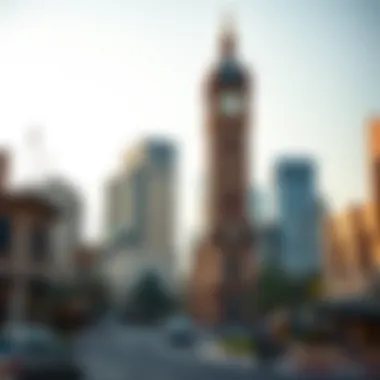

Furthermore, the Clocktower encourages social interactions amongst locals and visitors. Many choose to linger in the area, enjoying street performances or taking photographs, creating an inviting atmosphere that celebrates diversity. This interaction cultivates unity among different cultures, reinforcing the Clocktower’s role in promoting community ties amid Dubai’s rapid urbanization.
"The Deira Clocktower is not just a timepiece; it is a timeless anchor that connects the past, present, and future of Dubai's ever-evolving urban landscape."
Tourism and the Clocktower
The Deira Clocktower stands as a testament to Dubai's rich history and bustling present, acting as a capstone in the city's vibrant tourist environment. Its prominence isn’t just in its physical structure but also in the multitude of experiences it offers. Tourists flock to this grand landmark not merely to take a photograph but to weave themselves into the narrative of Dubai—a city that has transformed from a small trading port to a global metropolis. The Clocktower serves as a touchstone for economic growth, cultural exchange, and social interaction, illustrating how tourism and urban landmarks can intertwine to reflect a city's identity.
Visitor Experience and Expectations
When travelers set foot in Dubai, they often come with an idea of what awaits them. The Deira Clocktower, a central figure in this expectation, offers an immersive experience that blends historical context with modern allure. Visitors can expect to see tourists from around the globe gather around its base, creating a lively atmosphere reminiscent of a bustling market in bygone days.
From the moment they approach, the Clocktower’s towering presence commands attention. Its intricate design invites admiration, while the surrounding area buzzes with local shops and eateries that tempt the palate. As people walk by, the interplay of light against the clock’s face at various times of the day provides a captivating visual spectacle.
Some might even participate in guided tours that expound on its history and architectural features, enhancing their understanding and appreciation. Tourists are often left in awe of the blend between the old-world charm of Deira and the modern skyscrapers dotting the skyline, marking a distinct juxtaposition where past and present collide.
Cultural Events and Celebrations
Throughout the year, the Deira Clocktower doesn't just stand out as a landmark; it also serves as a cultural hub for various community gatherings and celebrations. Local festivals are often centered around this iconic symbol, providing opportunities for residents and tourists alike to engage with Dubai’s diverse cultural tapestry.
During the Eid celebrations, for example, the area around the Clocktower transforms into a vibrant focal point where art displays, traditional performances, and food stalls come alive. Tourists are encouraged to immerse themselves in the festivities, sharing in the spirit of unity and celebration that local communities pride themselves on.
Furthermore, local initiatives sometimes position the Clocktower as a backdrop for art exhibitions, open-air markets, and interactive workshops, inviting everyone to participate. This ability to facilitate social interactions enriches the visitor experience and often leads to unforgettable memories that visitors cherish long after their journey.
Symbolism in Tourism Marketing
The Deira Clocktower is not just an architectural marvel; it has become a vital element in Dubai's tourism marketing strategy. Its image is frequently found in promotional materials, from brochures to digital campaigns. The symbolism attached to the Clocktower extends beyond its physicality and taps into the identity of Dubai itself—reflecting progress, history, and multiculturalism.
The slogan "Where past meets future" accompanies many visual displays of the Clocktower, suggesting that tourism in Dubai encapsulates both tradition and modernity. This duality is appealing not just for leisure travelers but also for investors looking at potential opportunities in an evolving market.
Moreover, with the emphasis on sustainable tourism, the Clocktower symbolizes balance. It asserts the importance of maintaining heritage amidst urban development, aligning with Dubai's vision for a sustainable future as it grows. Hence, it serves both as an icon of the past and a beacon for future tourism endeavors.
In summary, the Deira Clocktower is imbued with significance far beyond its physical structure. It offers a dynamic visitor experience, hosts cultural events, and plays a vital role in the marketing narrative of the city. As the landscape of Dubai continues to evolve, its landmark remains a steadfast reminder of the interconnections between tourism, identity, and community.
Current Relevance in Dubai's Identity
The Deira Clocktower serves as more than just a mere landmark; it is a crucial element of Dubai's identity, symbolizing the city's rapid evolution. As one gazes upon its structure, the Clocktower reflects the blend of Dubai’s rich history with its futuristic aspirations. Not only does it stand tall amidst the bustling urban environment, but it also anchors the community with a sense of place and continuity.
Representation in Popular Culture
The Deira Clocktower has made its imprint on popular culture, becoming a subject in local art, media, and even social media. Often captured in photographs on platforms such as Instagram, it represents the blend of old and new Dubai. Artists might depict the Clocktower in various styles, highlighting its buzzy surroundings, or even creating murals that pay homage to this iconic structure. Similarly, it's a backdrop for various films and television shows that showcase life in the UAE. Its representation isn't merely aesthetic; it symbolizes the juxtaposition of tradition and modernity that characterizes Dubai itself.
Public Perception and Community Attachment
The community's attachment to the Deira Clocktower remains strong, as it's more than just a timekeeper. Locals often gather around it, commemorating important occasions or simply meeting friends. The Clocktower fosters a sense of nostalgia, linking residents to their cultural heritage. Many people recall personal anecdotes, often recounting moments spent under its shadow during festivals or daily life. This kind of emotional connection reinforces its standing as a beloved community landmark, and thus, a vital piece of Dubai’s identity.
Educational and Awareness Programs
Programs aimed at educating locals and tourists about the Deira Clocktower's significance have become increasingly essential. Various initiatives now incorporate the Clocktower in guided tours, which discuss its historical background and architectural features. Schools in the area may include field trips that focus on this landmark, fostering a sense of pride among students. Additionally, workshops led by local historians involve community members in preserving their cultural history, emphasizing the Clocktower’s role as a touchstone in Dubai’s ongoing story. These educational efforts work tirelessly to raise awareness among both residents and visitors, ensuring that the Deira Clocktower's relevance will endure, not only as a physical structure but also as a symbol of unity and heritage.
"The Deira Clocktower is not just a reminder of time but a beacon of identity, connecting the past with the vibrant present of Dubai."
By understanding and appreciating the Deira Clocktower's role today, one begins to see how it fits into the larger narrative of Dubai's ongoing transformation from a small port town to a dynamic global city.
Challenges Facing the Landmark
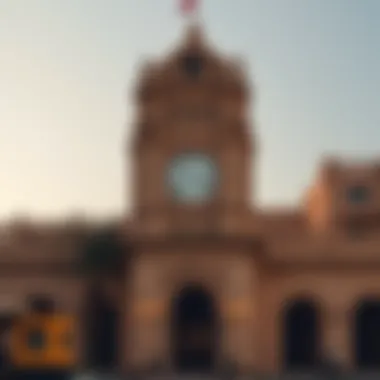

The Deira Clocktower stands as a resilient symbol of Dubai’s history and cultural heritage. However, like many historical landmarks, it faces a slew of challenges that threaten its preservation and relevance in the ever-quickening pace of urbanization. Recognizing these issues brings to light the delicate balance between maintaining a city’s history while fostering its growth through modernization and urban development.
Maintenance Issues
One of the primary hurdles for the Deira Clocktower is maintenance. Every structure, especially those that have weathered decades and witnessed the changing tides of time, requires regular upkeep. The intricate details that adorn the clocktower, from its facade to its mechanical components, often suffer from the elements. Dust storms, humidity, and the wear and tear from urban life contribute significantly to its deterioration.
Maintaining a structure that embodies so much history necessitates not just repairs but also a deep understanding of its original structure. This can sometimes be a daunting task as older methods of construction do not comply with modern standards. The clocktower’s historical significance can complicate these maintenance efforts. Care must be taken to ensure that renovations do not strip it of its character, thus calling for preservation experts who can blend contemporary practices with historical accuracy.
Urbanization Pressures
Urbanization in Dubai has been nothing short of dramatic. As areas around the clocktower rapidly develop into commercial and residential zones, the clocktower faces increasing urbanization pressures. This growth often raises concerns among locals and heritage advocates about the risk of overshadowing the landmark.
The vicinity around the Deira Clocktower is bustling with new projects. Fresh business hubs are built, and public spaces are redefined, often at the expense of traditional landmarks. Resources that could be allocated for the preservation of such iconic structures may instead be funneled into newer developments. In this sense, the clocktower serves as a battleground for the competing interests of heritage preservation and economic advancement.
Balancing Development with Heritage
Striking a balance between development and heritage preservation is perhaps the most intricate challenge the Deira Clocktower confronts. As one of the only structures that narrates the story of Deira’s evolution, it plays a crucial role in reflecting Dubai's journey. Yet, the reality is that without new investments and developments, local businesses may struggle to thrive.
A collaborative approach could be the key. Stakeholders, including city planners, heritage specialists, and community members, must come together to discuss how the clocktower can be integrated into future urban plans. There are potential initiatives, such as adaptive reuse projects, that might enable the landmark to coexist harmoniously with the expanding cityscape, turning it into a tourist hub while respecting its roots.
"The preservation of our historical landmarks must be a priority, not just for nostalgia, but to keep our identity intact in a rapidly changing world."
By addressing these challenges head-on, the Deira Clocktower can continue to be a cherished emblem of Dubai’s rich tapestry, allowing future generations to appreciate its story while adapting to a modern urban environment.
Further insights can be found in resources such as Wikipedia, offering comprehensive historical context, or Britannica, detailing the wider impact of urban development on cultural sites.
Future Prospects
The Deira Clocktower stands as not just a nostalgic nod to the past but a beacon pointing toward what lies ahead in a rapidly evolving Dubai. Its future prospects carry weight not only in architectural and urban planning dialogues but also resonate deeply with cultural identity and community character. As Dubai forges its path towards becoming a more sustainable and livable metropolis, the clocktower sits at a pivotal juncture, prompting discussions about preservation, revitalization, and innovative urbanization strategies.
Potential Revitalization Projects
Revitalization projects for the Deira Clocktower might encompass transforming the clocktower square into an interactive public space, including gardens, exhibition areas, and performance venues. Such initiatives could enhance visitor experiences and foster community engagement. An example could be creating walking paths lined with artistic installations that echo the city's rich history. Food trucks or local artisan markets can also breathe new life into this area, drawing both tourists and residents together.
With the push for greener cities, integrating elements like vertical gardens might bring a breath of fresh air, quite literally. Furthermore, digital displays could highlight the tower’s historical significance while providing visitors with augmented reality experiences, enriching any exploration of the area. These projects could provide economic stimulus through job creation and increased foot traffic, making a win-win scenario for local businesses.
Role in Dubai's Vision for
Dubai's Vision 2040 aims to create a city that is livable and sustainable, all while preserving its unique heritage. The Deira Clocktower's role in this vision could serve as a focal point for cultural tourism that showcases historical architecture while promoting economic growth. As part of this strategy, the clocktower could integrate into wider urban designs aiming to blend modern aesthetics with historical depth, appealing to investors and developers alike.
Efforts to enhance transportation links surrounding the clocktower can also contribute to this vision. Expanding public transport options not only makes the area more accessible but encourages a balanced development approach that harmonizes old and new. By fostering a narrative that connects the clocktower's history to the futuristic ambitions of Dubai, the city can create an inclusive environment that values heritage while embracing forward-thinking growth strategies.
Continuing Cultural Legacy
A robust cultural legacy is essential for any city's identity, and the Deira Clocktower is a key player in maintaining that legacy. Keeping its narrative alive means engaging community members in storytelling, cultural festivals, and educational programs that resonate with both locals and visitors. The possibility of establishing a cultural center nearby can create opportunities for workshops, exhibitions, and lectures that share the clocktower's historical context.
Additionally, leveraging technology can help in this ongoing cultural narrative. Virtual tours could offer educational experiences for schools and enhance community understanding of the clocktower's importance. Collaborating with artists for site-specific installations promotes cultural exchange, sparking curiosity and attracting a younger demographic.
To encapsulate, the Deira Clocktower is positioned to evolve directionally with Dubai's aspirations while understanding its past. Ensuring that the landmark retains its cultural significance amid rapid urbanization is paramount to creating a future that reflects shared values and community pride.
"The clocktower is more than just a timepiece; it's a living testament to Dubai's journey through time."
Closure
Reflecting on the Deira Clocktower’s significance reveals its pivotal role in the larger story of Dubai’s urban evolution. This landmark stands as a witness to the city’s rapid transformation from a modest trading post into a bustling metropolis. It is not just a clocktower; it serves as a cultural icon, a historical marker, and a focal point around which the community has rallied.
Understanding the Significance
The importance of this article lies in its ability to connect the dots between the Clocktower’s historical roots and its contemporary relevance. For investors, realtors, and developers, recognizing the Clocktower's value can influence urban planning and economic strategies. It showcases how historic sites can coexist with urban growth, providing a glimpse into sustainable development practices that honor heritage while inviting modernity.
Benefits of Preservation
As we contemplate the future of the Deira Clocktower, it’s imperative to weigh the benefits of preservation. Retaining such landmarks not only enhances property values in surrounding areas but also nurtures community pride. The Clocktower acts as a bonding agent for residents and visitors alike, bringing to life the rich tapestry of Dubai’s history. It's a reminder that the past can inform present action, guiding future urban landscapes with subtler touches of tradition.
Considerations About Future Growth
As Dubai continues its rapid growth, the relationship between new developments and existing landmarks will only intensify. This article encourages a forward-thinking perspective where urban developers incorporate historical perspectives into their projects. The Deira Clocktower can model this thoughtful balance of innovation and respect for the past, setting a benchmark for future city planning endeavors.









